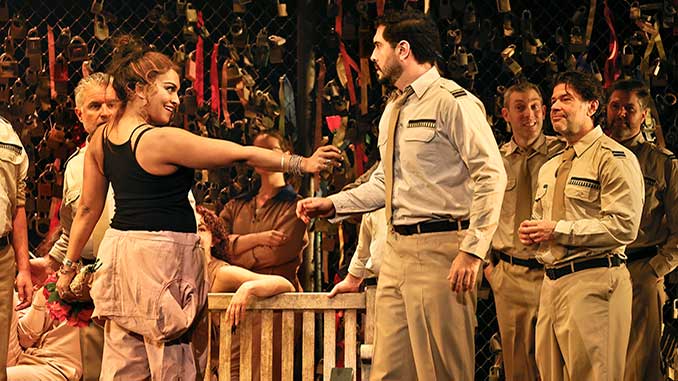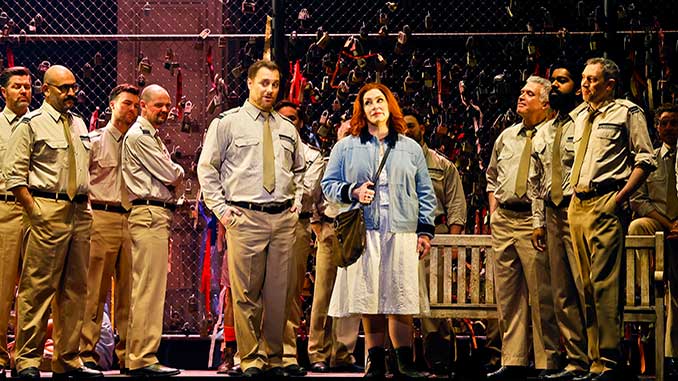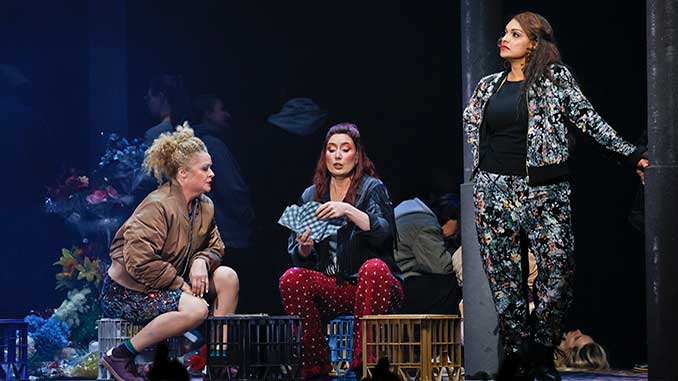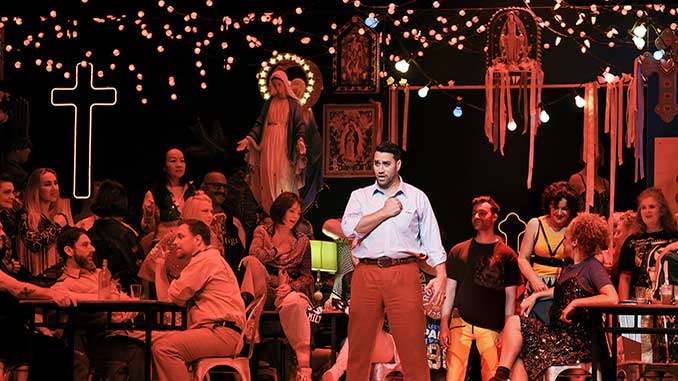
17 November 2025

Melbourne’s Regent Theatre curtain had barely lifted to expose half the stage when the woman seated beside me let out a wow at the opening of Opera Australia’s (OA) new production of Carmen.
When fully revealed, the sight is little more than a high steel fence smothered to arm’s length with what appeared to be love locks and red ribbons. But an evocative image to a story where passion binds, wounds and destroys made a strong impact.
In front of the fence sit two park benches – behind it, a large stone pedestal supports a looming elaborate cross. For Georges Bizet’s beloved opera – centered on a free-spirited woman who refuses to be claimed by any man – director Anne-Louise Sarks makes an instant point.

Facing the audience are symbols of unbreakable love juxtaposed with those of love broken, represented by tied ribbons characteristic of the Loud Fence movement and its reckoning with institutional abuse.
Adding to this, Sarks’ combination of contemporary aesthetics, punchy color and religious iconography provides a striking canvas for the complexity of love which is constantly referenced throughout the work.
Importantly, 150 years on from the opera’s premiere, the title character – one of opera’s most badass, headstrong and sultry leading characters who belts out some gorgeously seductive music – can be perceived differently.
Carmen exists in a society – here, remaining in the story’s setting of Seville and the surrounding hills – that enjoys more freedoms than would have been imagined at its premiere in 1875. Nevertheless, women remain the victims of domestic abuse and crimes of passion. Carmen has her flaws but her fate – killed by the soldier Don José who cannot bear to lose her – is never justified.

Furthermore, in cleverly surrounding Carmen with varying degrees of religiosity, Sarks perhaps is interrogating the forces that shape attitudes to love, guilt and possession in a setting where its cultural impact still exists – Contributions by creatives Marg Horwell (sets and costumes) and Paul Jackson (lighting) do well in sharpening this thematic thread.
Modern day Spain hosts a broad palette of attitudes to Christianity – whether it’s one of religious devotion, indifference or disbelief and mockery. And just as an individual is accountable for their actions and beliefs, institutions must answer for their influence. The Carmen Sarks prefers to present, I dare say, is a woman psychologically scarred by abuse.
Horwell’s fencing in Act 1 gives way in Act 2 to Lillas Pastia’s tavern, adorned with images of the Virgin Mary and glowing neon crosses. Act 3 shifts to a flood-lit roadside marked by towering light poles – one encircled with flowers to indicate a place of death – with Lillas Pastia’s just visible in the distance.
Another striking touch comes in Act 4 – vertical strings of lights frame Escamillo’s central dressing room, which suggests a florist’s shop, filled with brilliant blooms whose beauty we know to be ephemeral.

As the titular character and arresting choice for the role despite the mezzo-soprano voice type being commonly assigned, soprano Danielle de Niese brought vibrant colour, agility and sharp dramatic instinct.
A natural, persuasive actor, de Niese navigated Carmen’s shifting moods with ease, triumphed with a nuanced stage presence and crowned the final act with vocal fearlessness and emotional lucidity.
As Don José, Abraham Bretón impressed with a clear, focused tenor that grew in intensity as the drama darkened. Breton’s Act 1 Flower Song was sung with heartfelt simplicity, but it was the final confrontation with de Niese where his finest performance came in charting Don José’s unravelling with compelling emotivity.
Jennifer Black contributed a tender, luminously sung Micaëla, her warm soprano and calm presence neatly portraying the devout girl Don José’s mother wants him to marry.

As Don José’s rival, Phillip Rhodes made a suave and commanding Escamillo, his resonant baritone perfectly suited to the bullfighter’s swagger. And with all the polish, charm and bravado one hopes for in delivering the iconic Toreador Song, the audience responded rapturously.
Carmen’s friends Frasquita and Mercédès were vivaciously drawn by Jane Ede and Angela Hogan while smaller roles echoed the consistent vocal and dramatic quality.
The OA Chorus – men, women and some endearingly excited children – were uniformly excellent, singing with clarity and vitality while enriching every moment they touched.

In the pit, making her Opera Australia debut, Italian conductor Clelia Cafiero led a brisk and astutely contoured reading of Bizet’s score, balancing clarity with supple modulation and lyricism.
Orchestra Victoria responded superbly, their expertise elevating the performance markedly – particularly noteworthy were the overture and following three act preludes which glowed confidently to establish the dramatic pulse.
In all, Sarks’ objective to create “a Carmen for the 21st century” has resulted in one having ample agency. And, while still in its first season after premiering earlier in the year in Sydney and needing perhaps some minor stage blocking to add finesse, there resides in it a satisfying amount of thought-provoking imagery and drama to last for years.
Carmen
Regent Theatre, 191 Collins Street, Melbourne
Performance: Saturday 15 November 2025
Season continues to 25 November 2025
Information and Bookings: www.opera.org.au
Images: Danielle de Niese as Carmen and Abraham Bretón as Don José in Opera Australia’s production of Carmen (2025) – photo by Jeff Busby | Nathan Levy as Morales and Jennifer Black as Micaëla in Opera Australia’s production of Carmen (2025) – photo by Jeff Busby | Angela Hogan as Mercedes, Danielle de Niese as Carmen, Jane Ede as Frasquita and Opera Australia Chorus in Opera Australia’s production of Carmen (2025) – photo by Jeff Busby | Angela Hogan as Mercedes, Jane Ede as Frasquita and Danielle de Niese as Carmen in Opera Australia’s production of Carmen (2025) – photo by Jeff Busby | Phillip Rhodes as Escamillo in Opera Australia’s production of Carmen (2025) – photo by Jeff Busby | Opera Australia Dancers in Opera Australia’s production of Carmen (2025) – photo by Jeff Busby
Review: Paul Selar

Leave a Reply